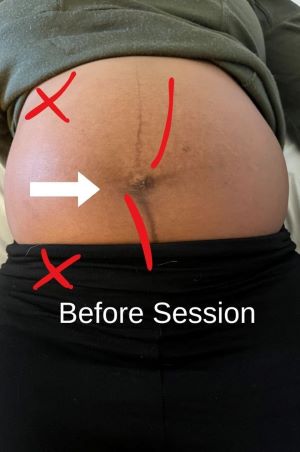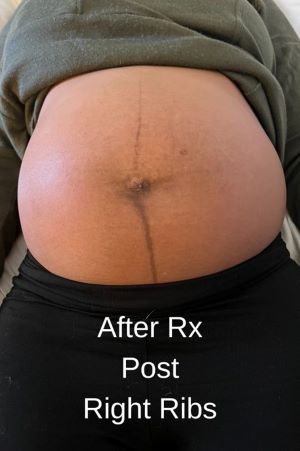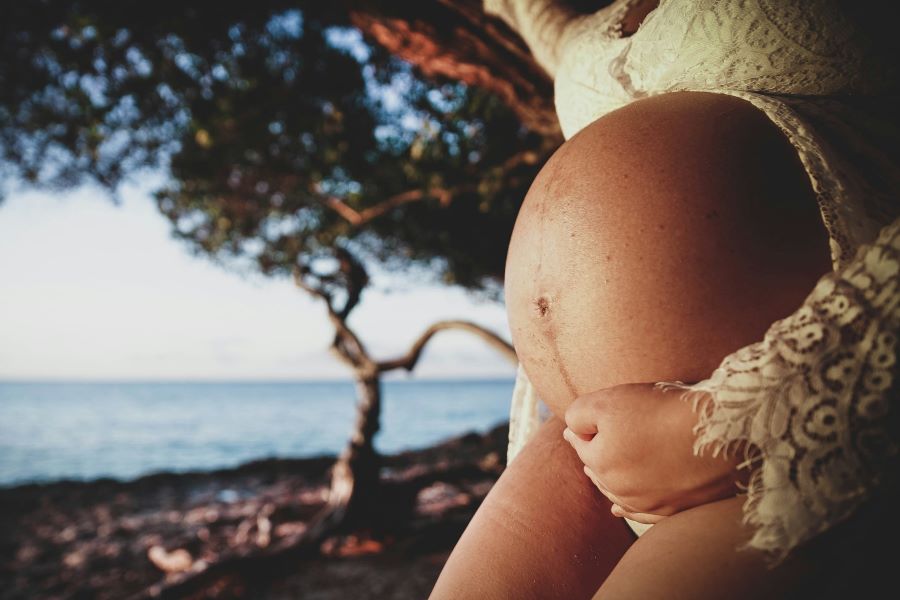Case Study: Preparing the Pregnant Body for Birth
Lynn shares a recent case study on her work with a pregnant client where she focused on bringing balance and creating space in the body to help her client prepare for birth. During her session, she was able to get her client out of pain and increase the effectiveness of her client’s pelvic muscle mobility. Lynn shares the wisdom she learned from one of the 2024 Birth Healing Summit speakers on how to find tightness in the pregnant body.
Client History: Amy (not her real name) came to see me when she was 20 weeks pregnant with her first baby. Her primary complaint was tailbone pain with radiating pain on her left side into her buttock and hip. She reported more frequent urination in the last two weeks, and painful intercourse both with insertion and thrusting. She desired an unmedicated birth, but was not quite sure where she wanted to have her baby.
Assessment and Treatment (Session 1): Upon assessment, I found her sacrum and tailbone slightly off to the right, with more tension in her right coccygeus muscles. Her coccyx had decreased mobility to PA mobilization. I also assessed her uterine mobility and found tightness in her right round and broad ligaments, and her fundus was off to the right like it was side-bending to the right. I treated her uterine ligaments and increased her uterine mobility and position of her fundus to be more upright.
Internally, I used the Schulte Hold on the pelvis to release the right coccygeus muscle and noted her coccyx had greater mobility to PA mobilization. Her pelvic floor muscles had more even tone and strength afterward. We then worked on pushing and expanding her pelvic floor. She was able to push and expand in all positions, with side-lying and hands and knees as her more productive positions. In supine, she struggled with letting her pelvic floor muscles lengthen.
Assessment (Session 2): I then saw Amy, again, at 38 weeks pregnant, where she reported her tailbone was much better, but she was complaining of some increased symphysis pubis pain. The pain was located more on the left side, and Amy was also experiencing left round ligament and left hip pain. The baby was head down and engaged in the pelvic inlet. On examination of her linea nigra, the lower line was shifting to the right as it made its way up into her umbilicus.

Here is a picture of her belly before her treatment in session 2. Notice the lower line pulling off to the right near the umbilicus and the upper line heading toward the right hip.

Here is the position of the baby’s head before treatment in session 2. It was only slightly off-centered, but not by much. This picture doesn’t show it well but the baby’s head was just slightly off to the left-hand side.
Treatment (Session 2): For treatment, I found the right posterior ribcage tight and her right gluteal muscles and hip external rotators were tight. I worked with her in left side lying to address these two issues.
Then I worked with her right round ligaments and her right lower abdominal fascia and got some release in those tissues.
The shape of her pregnant belly changed slightly after this release. I also did some internal work and found her left side pelvic floor muscles had increased tone, which I released.
After these treatments on the pregnant body, I had her practice pushing, again, to help prepare her body for birth. Amy was better able to let her pelvic floor muscles bulge in side-lying and hands and knees. Pushing in supine was still not as good, though, so I continued the treatment. The most dramatic change was having her do an inversion after all the bodywork, and it created a shift in the pregnant belly that is quite visible in the images below.
Below are images as we progressed through her treatment:

After treatment of the right posterior ribcage, the right gluteal muscles and the hip external rotators

After treatment of the right round ligaments and the right lower abdominal fascia

After treatment and bodywork was completed, and the client did an inversion
You can see in these images how even her belly is after the inversion. The roundness on either lateral side is the same, whereas before, there was more roundness on the left side. Her linea nigra line is looking more straight, and she no longer had any symphysis pubis pain. She felt better after her session, and I felt she we had done our best to prepare her for birth and alleviate the pain she was experiencing in her pregnant body.
Client Outcome: I look forward to hearing how her birth goes when I see her for her postpartum visit. It would have been interesting to see how an inversion at the beginning of the session might have changed things, but I didn’t do that. I also didn’t take a picture of the baby’s head position as it was slightly off, and I didn’t think a picture would show anything, but I did feel there was a slight change to the baby’s head after the inversion, too.
Conclusion: Bringing balance and creating space in our clients’ pregnant bodies not only helps clients get out of pain, but it also allows babies to get into the best position possible for labor, and is an important role we, as bodyworkers, bring to our pregnant client sessions.
I wanted to share this case study with you to demonstrate how we can use the linea nigra as an indicator of where there is tightness in the body and where we should be working to help assist our clients with their births. Thank you, Gabrielle Brennan, for sharing your wisdom with me! Check out the Birth Healing Summit launching April 2024 as Gabriella talks about this in her interview on fetal positioning. Join the IBH Newsletter if you aren’t already on it to get updates on the Birth Healing Summit.
About the Author: Lynn Schulte is a Pelvic Health Therapist and the founder of the Institute for Birth Healing, a pelvic health continuing education organization that specializes in prenatal and postpartum care. For more information, go to https://instituteforbirthhealing.com

